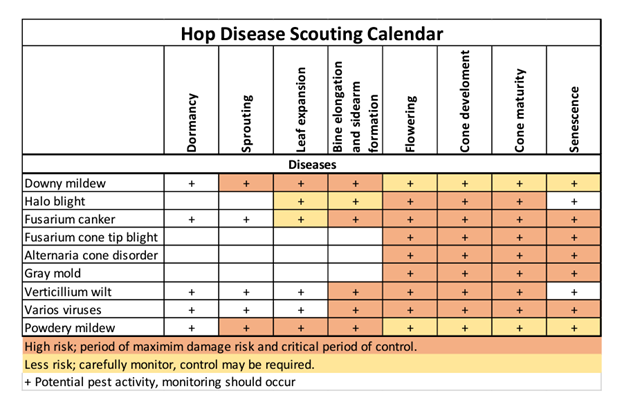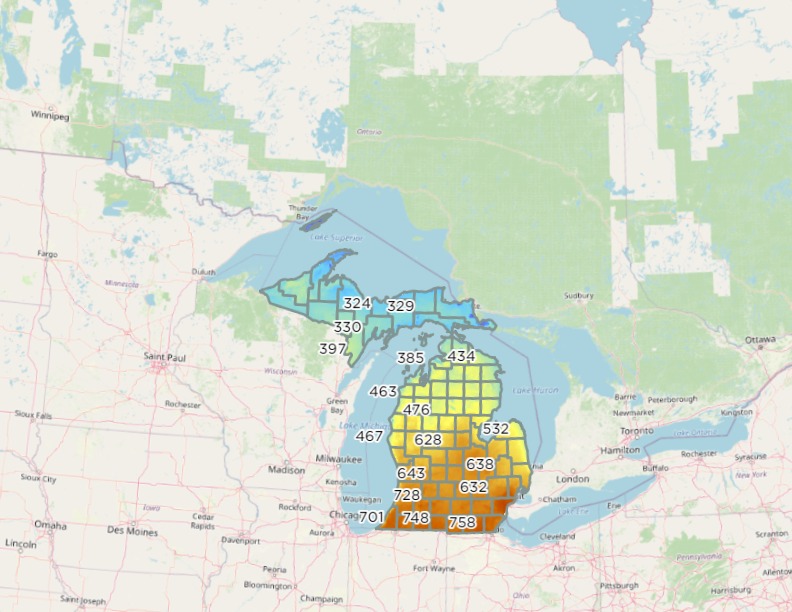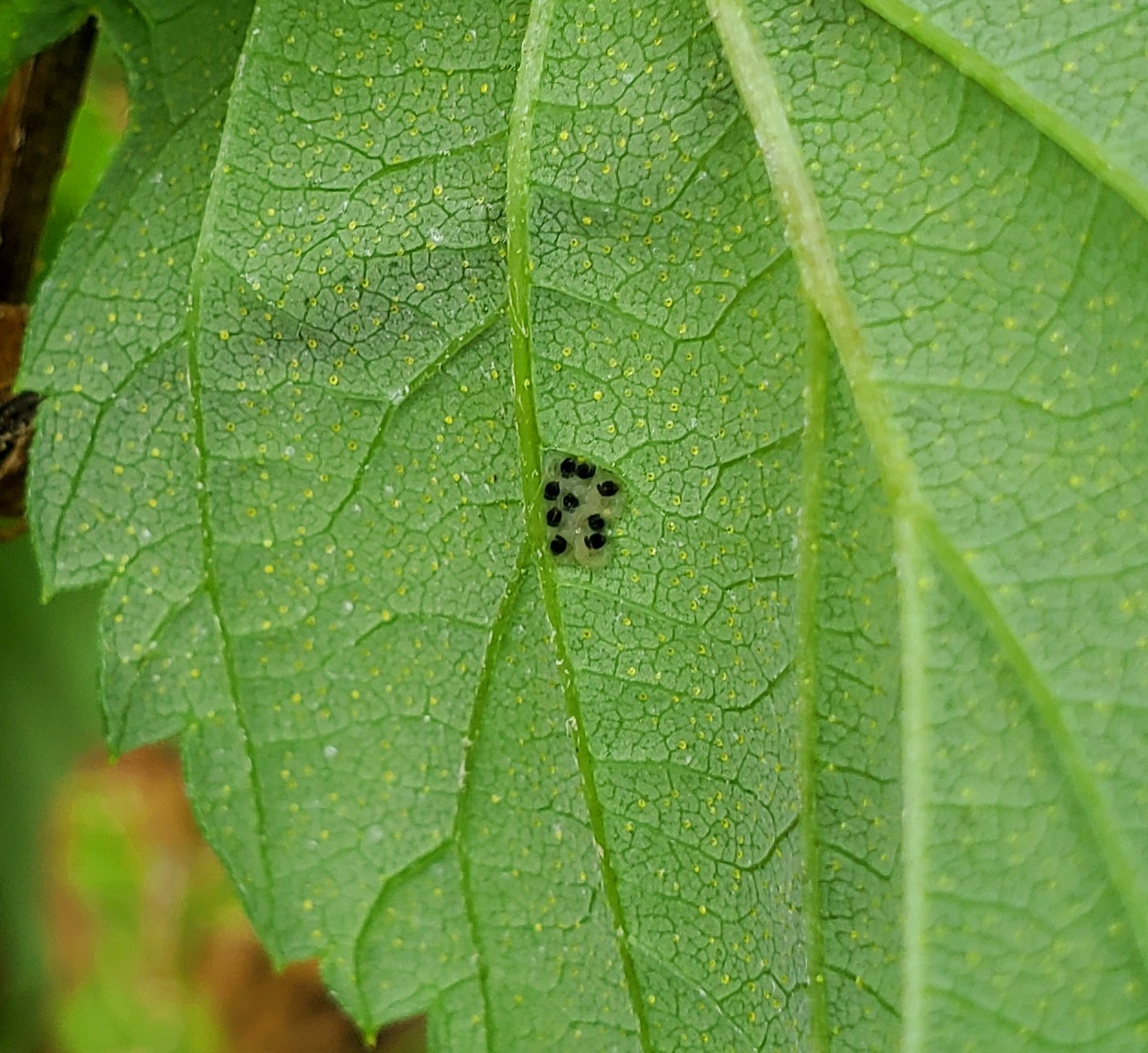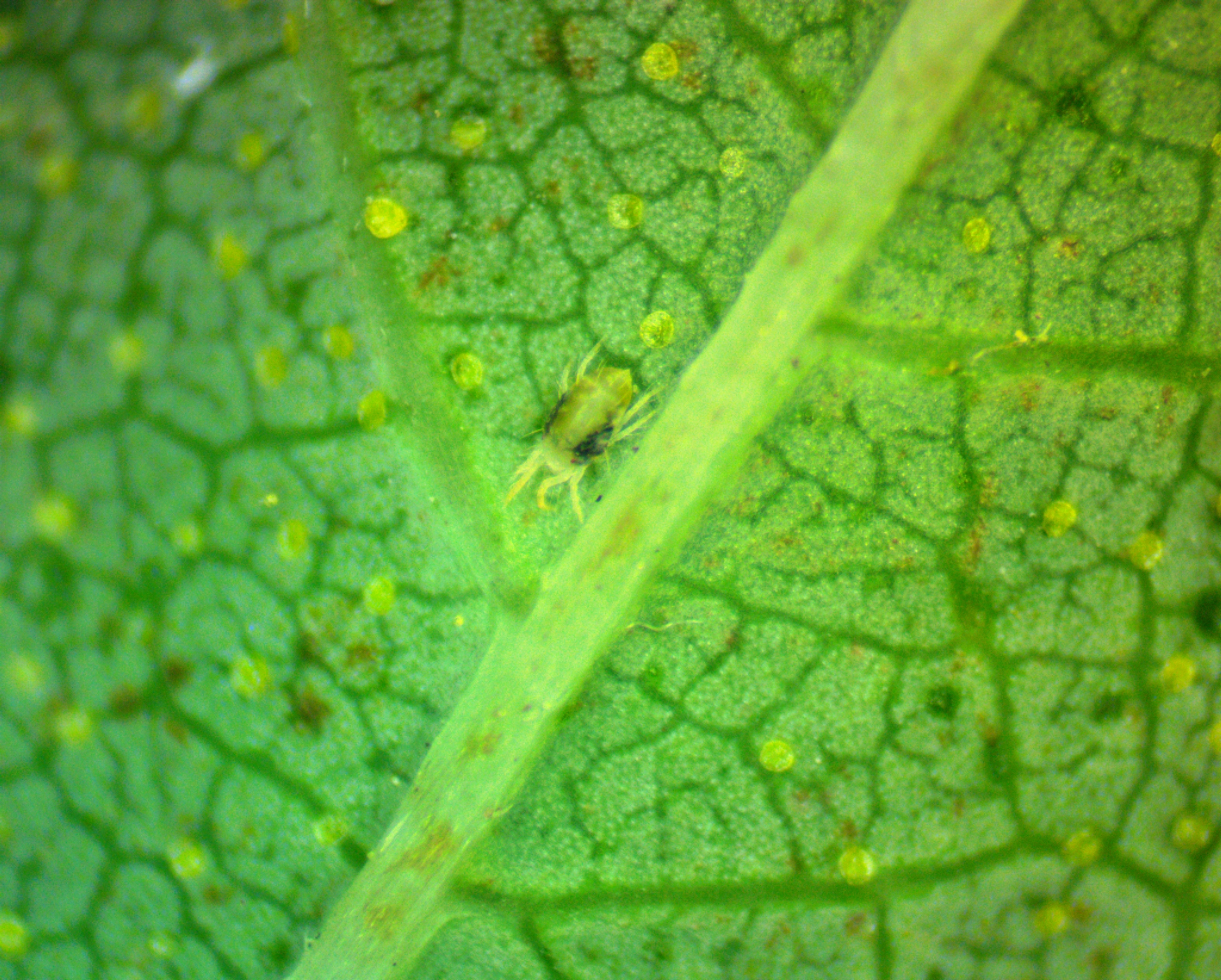Michigan hop pest report week of June 6, 2024
Michigan hopyards are in a critical pest management period for key insect pests and diseases. Scout regularly and thoroughly.
In the field
For a hop production update from around the state, please see the hop crop report for June 6, 2024.
Weeds
With the early warm up and ample rain, many growers are fighting an uphill battle against weeds, particularly those not using preemergence herbicides. Additionally, the fast warmup made it tough to get early glyphosate applications before hop bines developed and greened. Grass weeds need to be treated when small for optimal control. Some growers use various forms of cultivation to suppress weeds. Refer to the Michigan Hop Management Guide for weed control options.
Diseases

The risk of halo blight infections is heating up and the weather has been conducive for downy mildew so growers need to stay on top of protective fungicide applications. Growers should also be on the lookout for powdery mildew infections. Windy wet weather has led to some difficulty in maintaining fungicide coverage for many growers.
The following section contains information on fungicide-based disease management. In all instances, it is important to manage fungicide resistance and avoid applying similar products back-to-back. This is particularly important with site-specific systemic fungicides. To reduce the development of resistance with systemic fungicides:
- Do not make more than three applications per season of the same Fungicide Resistance Action Committee (FRAC) code, regardless of if it is allowable based on the label.
- Do not make two consecutive applications of the same FRAC code.
- Rotate with unrelated fungicides in a different FRAC code that have efficacy on the target pathogen.
Downy mildew
Downy mildew infection symptoms are visible in hopyards. Downy mildew is caused by the fungus-like organism Pseudoperonospora humuli and is a significant disease of hop in Michigan, potentially causing substantial yield and quality losses. This disease affects cones, and foliage and can become systemic; in extreme cases, the crown may die. Cool and damp weather during the spring provide ideal growth conditions for the pathogen. Disease severity is dependent on cultivar, environmental conditions and management programs. Growers should focus on proactive management strategies, including 1) sourcing clean planting stock, 2) clean crown management in the spring, 3) scouting regularly and 4) utilizing a preventative fungicide program.
Scouting for downy mildew involves monitoring the crop for signs and symptoms of disease to evaluate the efficacy of the control program being utilized and gauge the level of disease pressure throughout the season. Growers should keep records of their scouting, including maps of their fields, a record of sampling and disease pressure, and the control measures used. Scouting should begin as soon as plants begin to grow and should continue until the crop is dormant.
To begin scouting, section your farm off into manageable portions based on location, yard size and variety and scout these areas separately. It is more practical to deal with blocks that are of the same variety, age and spacing. Walk diagonally across the yard and along an edge row to ensure you view plants from both the edge and inner portion of the block. Change the path you walk each time you scout to inspect new areas. Reexamine hotpots where you have historically encountered high mildew pressure. Weekly scouting is recommended at a minimum.
Unfortunately, even when best management practices are followed, downy mildew can gain a foothold in Michigan yards due to high disease pressure, challenges with fungicide application timing, suboptimal spray coverage, fungicide wash-off, cultivar susceptibility or a combination of these factors. In addition, fungicide resistance and infected nursery plants may play a role in some disease control failures. Recent research from Higgins et al., unpublished, indicates that fungicide resistance in hop downy mildew is not widespread in Michigan for popularly used fungicides with FRAC code 40. See the list of recommended fungicides below for more information on FRAC code 40 fungicides.
Clean planting material should be used when establishing new hopyards since many insect and disease pests are readily spread via nursery stock. Growers should consider purchasing a few plants from prospective nurseries and have them tested for diseases including mildews and viruses before committing to a large numbers of plants. Additionally, any other signs of poor handling at the propagator level may be used as an indicator of plant quality. Other signs of poor handling would include mite or aphid infestations, spray damage or poor root development and would be grounds for rejecting a delivery of plants.
Growers should utilize a protectant fungicide management strategy to mitigate the risks of early and severe infections but can also utilize cultural practices to reduce disease. Keep in mind that varieties vary widely in their susceptibility to downy mildew and select the more tolerant varieties when possible (refer to Table 2 in the Field Guide for Integrated Pest Management in Hops).
On mature plants, removal of the first flush of growth can help suppress disease development if disease is already present in the yard from the previous season. The early growth should be completely removed using mechanical or chemical pruning. As bines develop (8-10 feet), the removal of superfluous basal foliage and lower leaves to promote air movement in the canopy and reduce the duration of wetting periods is recommended. This is commonly achieved through multiple applications of Aim herbicide or concentrated nitrogen fertilizer solutions. Aim will also control smaller weeds within the row. Using Aim, pruning and/or crowning should not be performed on baby hop plants (less than 3 years old). If there is a cover crop, it should be mowed close to the ground. If yards have no cover crop, cultivation can help to dry the soil and minimize humidity. Keep nitrogen applications moderate. For more information on pruning, refer to the Michigan State University Extension article “Pruning hops for disease management and yield benefits.”
Apply fungicide treatments on a protectant basis as soon as bines reach 6 inches in the spring regardless of the presence or absence of visible symptoms of downy. If growers are planning to remove the first flush of growth by pruning, the first fungicide application should occur only after regrowth. Applications should continue season long on a seven- to 10-day reapplication interval. The time between applications may stretch longer when the disease pressure is low, particularly after cone closure. Several periods in the season are particularly critical for disease control: immediately before and after training; when lateral branches begin to develop; bloom; and when cones are closing up. Covering young, developing bracts before cones close-up is critical to protecting against downy mildew when conditions for disease are favorable. Getting adequate coverage on undersides of bracts where infection occurs becomes increasingly difficult as cones mature.
Refer to the Michigan Hop Management Guide section on downy mildew for additional management information, including fungicide options.
Halo blight
Halo blight of hop is caused by the fungus Diaporthe humulicola and can cause yield losses and change the chemical composition of the hop cones. Halo blight of hop first appears in late spring to early summer as brown to gray lesions that develop on the hop leaves that are surrounded by a chlorotic (yellow to light green) halo. The lesions may have concentric rings radiating from the center of the leaf lesion, but rings may not be present. The pathogen can also infect hop cones and burrs. Hop burrs become necrotic and desiccated.
The pathogen overwinters on dried hop tissue as small black structures called pycnidia. When conditions are warm (greater than 60 degrees Fahrenheit) and humid, the pycnidia produce spores that are dispersed by wind and water. The pathogen causes lesions on the surface of the hop leaf that give rise to new pycnidia and the cycle continues with burr and cone infections occurring as plants develop. If environmental conditions are right, the hop plant can go through multiple infection cycles per year. In the late summer or early fall, the pathogen seems to colonize hop bines that have been left after harvest, where the pathogen remains dormant over the winter.
To help suppress halo blight, post-harvest dead material and new shoots should be removed in the fall to reduce overwintering inoculum. Post-harvest hop plants can also have the top layer of their crown removed in a process called crown pruning, which can reduce inoculum of the pathogen that can infect the hop crown. Additionally, there appears to be a correlation between the severity of downy mildew symptoms and the severity of halo blight symptoms, therefore early season downy mildew disease management can be a preventive measure against halo blight in hops.
Chemical control of halo blight is often needed. The disease is present throughout the growing season, so multiple chemical applications are needed. There is evidence that fungicides registered for powdery mildew with the active ingredients trifloxystrobin (FRAC 11), flutriafol (FRAC 3), tebuconazole (FRAC 3) and fluopyram (FRAC 7) have been shown to reduce the incidence and severity of halo blight symptoms.
For more information on halo blight management, refer to the MSU Extension publication, Managing Halo Blight of Hops.
Powdery mildew
In addition to downy mildew, be vigilant in scouting for and managing powdery mildew, which may be a bigger issue this year as conditions are hot and dry. Powdery mildew of hop (caused by the fungus Podosphaera macularis) is an important but sporadic disease in Michigan hopyards. Seasonal powdery mildew disease severity is dependent on cultivar, environmental conditions and management programs. Focus on proactive management strategies, including sourcing clean planting stock, scouting regularly and utilizing a preventative fungicide management program.
Powdery mildew resulting from bud infection appears in the spring white stunted shoots called “flag shoots.” Flag shoots are rare, accounting for less than 1% of all shoots in a field and making detection at this stage very difficult. Secondary lesions become visible as leaf tissue expands and first appear as raised blisters, which quickly develop into white, round colonies. Infected burrs and cones can also support white fungal colonies or may exhibit a reddish discoloration if infected later in development.
Burrs and young cones are very susceptible to infection, which can lead to cone distortion, substantial yield reduction, diminished alpha-acids content, color defects, premature ripening, off-aromas and complete crop loss. Cones become somewhat less susceptible to powdery mildew with maturity, although they never become fully immune to the disease. Infection during the later stages of cone development can lead to browning and hastened maturity. Alpha-acids typically are not influenced greatly by late-season infections, but yield can be reduced by 20% or more due to shattering of overly dry cones during harvest resulting from accelerated maturity.
Late-season powdery mildew can be easily confused with other diseases such as Alternaria cone disorder, gray mold, other cone diseases or spider mite damage. Several weak pathogens and secondary organisms can be found on cones infected by powdery mildew; limiting powdery mildew can reduce these secondary infections.
Conditions that favor powdery mildew are reported to include low light levels resulting from cloud cover, canopy density, excessive fertility and high soil moisture. Leaf wetness from dew or rain does not directly impact powdery mildew infection, but results from high humidity and cloud cover, which favors disease. Temperatures from 46 to 82 F allow powdery mildew to develop, but disease is favored by temperatures of 64 to 70 F; disease risk decreases when temperatures consistently exceed 86 F for six hours or more.
Limiting powdery mildew is best approached by integrating resistant varieties, sourcing clean planting material, following crop sanitation practices, limiting early season disease establishment, optimizing fertilization and irrigation, and well-timed fungicide applications. While you may not be able to select resistant varieties because of market factors, some resistant varieties are available. The reaction of a hop variety to powdery mildew varies depending on where it is grown and which isolates of the fungus are present. Generally, Columbus, Cashmere and Galena are considered susceptible; Centennial and Chinook are intermediate; Nugget, Newport and Cascade are resistant, although races of the fungus present in Pacific Northwestern U.S. can overcome the resistance in the varieties as well.
Begin managing powdery mildew in early spring by thoroughly removing all green tissue during pruning. The goal of this early pruning is to remove the hard-to-locate flag shoots and delay or prevent infection. Eliminating flag shoots and early season disease requires removing all shoots, including those closest to the ground, on sides of hills and around poles or anchors. Mechanical pruning has been shown to be more effective than chemical pruning in eliminating flag shoots.
Pruning has not been widely adopted in Michigan but should be considered to minimize risk, particularly if you are experiencing intense powdery or active infections are reported in the region. Avoid pruning and removing basal foliage on baby hop plants (less than 3 years old). For more information on pruning, refer to the MSU Extension article, “Pruning hops for disease management and yield benefits.”
Regular fungicide applications are needed to prevent infection and are applied regardless of visible symptoms. Appropriate timing of the first fungicide application after pruning is important to keep disease pressure at manageable levels. This application should be made as soon as possible after shoots reach 6-10 inches or regrow in pruned yards. Different fungicides are utilized for powdery mildew control during three distinct periods of the season: emergence to mid-June; mid-June to bloom; and bloom to preharvest. The FRAC mode of action classification codes are included to help growers make resistance management decisions.
Emergence to mid-June (current conditions)
Consider a combination of applications of sulfur (FRAC M2), oils, Flint (trifloxystrobin, FRAC 11), Rhyme (flutriafol, FRAC 3), Procure 480 SC (triflumizonle, FRAC 3) or Unicorn DF (tebuconazole + sulfur, FRAC 3 + M2). Under high pressure, tank mix with oils and integrate copper (FRAC M1) into your downy mildew programs when possible. Avoid tank mixes of copper and sulfur, as phytotoxicity may occur.
Mid-June to bloom
Consider Rhyme (flutriafol, FRAC 3), Procure 480 SC (triflumizole, FRAC 3), Luna Experience (fluopyram + tebuconazole, FRAC 7 + 3), Vivando (metrafenone, FRAC 50), Gatten (flutianil, FRAC U13) and Torino (cyflufenamid, FRAC U6). Under high pressure, tank mix with oils and integrate copper into your downy mildew programs when possible.
Bloom to preharvest
Use a combination of Quintec (quinoxyfen, FRAC 13, 21-day preharvest interval), Pristine (pyraclostrobin + boscalid, FRAC 11 + 7, 14-day preharvest interval), Luna Sensation (fluopyram + trifloxystrobin, FRAC 7 + 11, 14-day preharvest interval), Vivando (metrafenone, FRAC 50, 14-day preharvest interval), Gatten (flutianil, FRAC U13) and Torino (cyflufenamid, FRAC U6, six-day preharvest interval).
Many fungicide programs can give adequate disease control on leaves when applied preventively under low disease pressure. On cones, however, differences among fungicides are substantial. Mid-July through early August is an essential disease management period. The fungicide Quintec (quinoxyfen), Luna Sensation (fluopyram + trifloxystrobin), Vivando (metrafenone), Gatten (flutianil, FRAC U13) and Torino (cyflufenamid) are especially effective during this time and should be utilized in regular rotation when burrs and cones are present.
Fungicide applications alone are not sufficient to manage the disease. Under high disease pressure, mid-season removal of diseased basal foliage delays disease development on leaves and cones by lowering inoculum and increasing airflow. Do not apply desiccant herbicides until bines have grown far enough up the string so that the growing tip will not be damaged and bark has developed. In trials in Washington, removing basal foliage three times with a desiccant herbicide (e.g., AIM) provided more control of powdery mildew than removing it once or twice. Established yards can tolerate some removal of basal foliage without reducing yield. This practice is not advisable in baby plantings (less than 3 years) and may need to be considered cautiously in some situations with sensitive varieties such as Willamette. The potential for quality defects and yield loss increases with later harvests when powdery mildew is present on cones.
For additional information on powdery mildew of hop, refer to the MSU Extension article, “Managing hop powdery mildew in Michigan.”
Insects

There is a lot going on with insects this week! European corn borer is active, mite levels are building, potato leafhopper populations are high in some locations, particularly in southern Michigan, and the first rose chafer will begin emerging soon.
First flight of European corn borer is well underway in central and southern Michigan and has just started in the northern most reaches of the Lower Peninsula. To estimate adult flight in your region, refer to the Enviroweather European Corn Borer Model. European corn borer overwinters as larvae inside the host plant where it pupates (matures) in response to warming temperatures in spring. First generation flight of moths is expected at 450 growing degree days (GDD) base 50, based on a March 1 start date for GDD accumulation. Currently, GDD50 accumulation in the Lower Peninsula ranges from 280-590 GDD50, indicating adult flight has begun in some areas. First generation moth emergence will continue through 950 GDD base 50, with first generation females laying 200-500 eggs over a period of two to three weeks.

European corn borer egg development is driven primarily by temperature, but generally eggs hatch in approximately 12 days. Newly hatched larvae then feed externally on leaves for approximately seven days before boring into stems and petioles where they continue to feed and grow. Once inside the plant, observations in hop indicate that European corn borer larvae damage vascular tissue, disrupt the flow of nutrients and water and impede plant development. In hop, European corn borer larvae can be found in leaf petioles, sidearms, cone petioles (strigs) and bines. Their location and prevalence in the plant dictates the severity of damage. The most severe damage observed in Michigan hops occurs when hopyards are infested by first generation flight in June during bine elongation and subsequent sidearm and cone development stages. This early infestation greatly reduces yield and leads to variable cone maturity dates.
Growers should focus on scouting for adult moths and eggs to allow for corrective management before larvae enter the bine. European corn borer eggs are smaller than the head of a pin but are laid in visible groupings. Eggs are white when first laid but change to yellow and then develop a black spot (the larval head capsule) just before hatching. Eggs are likely deposited on the underside of hop leaves in masses of 20 to 30 and covered with a waxy film. If available, growers may have better luck scouting and spotting eggs in adjacent corn fields.
European corn borer larvae are light gray to faint pink caterpillars with a dark head and have dark spots along the sides of each segment and a pale stripe along the back. They grow to about 1 inch but start out very small at hatch and feed briefly on leaf tissue before boring into hop bines and even hop leaf petioles.
European corn borer pupae are smooth, reddish brown, cylindrical and about a half-inch long and found inside bines.
The European corn borer moth is about 1 inch long and light brown with wavy bands across the wings. The male is slightly smaller and darker. The tip of the body protrudes beyond the wings. Adult moths are most active in grassy areas before dawn.
Small European corn borer larvae are the intended target of insecticides, so monitoring for adult moth flight is critical to predicting the start of egglaying and the subsequent window of egg hatch. Begin monitoring and trapping well before predicted flight (450 GDD50) to avoid missing the beginning of flight.
For information on European corn borer management, refer to the MSU Extension article, “Be on the lookout for European corn borer in hops.”

Potato leafhopper have arrived in Michigan. Like many plants, hops are sensitive to the saliva of potato leafhopper, which is injected by the insect while feeding. Damage to leaf tissue can reduce photosynthesis, which can impact production, quality, and cause death in baby plants. The most common classes of insecticides recommended for control of potato leafhopper include the pyrethroids, neonicotinoids and organophosphates. Organophosphates and pyrethroids are broad spectrum and disrupt natural enemies often leading to very serious mite issues. These should be used with extreme caution and only when absolute to target another pest at the same time—for example, Japanese beetle on baby hops. Neonicotinoids are, by comparison, longer lasting and narrow spectrum, making them a solid choice for potato leafhopper management.
To learn more about potato leafhopper, refer to the hop potato leafhopper factsheet and the Michigan Hop Management Guide.
Twospotted spider mite populations continue to build, and growers may find they need to apply miticide earlier this year due to the early warm up. Growers should carefully monitor mite pressure as twospotted spider mite thrive under hot and dry conditions.
Twospotted spider mite is a significant pest of hop in Michigan and can cause complete economic crop loss when high numbers occur. Feeding decreases the photosynthetic ability of the leaves and causes direct mechanical damage to the hop cones. Leaves take on a bronzed and white appearance and can defoliate under high pressure. Intense infestations weaken plants, reducing yield and quality. Dry, hot weather provides ideal conditions for outbreaks.
Growers are encouraged to scout carefully for mites season-long and treat while populations are at low levels, when mites are most effectively managed. Refer to the twospotted spider mite factsheet for more information on identification and management and the Michigan Hop Management Guide for information on available miticides.

Stay connected!
For more information on hop production practices, please sign up for the hop MSU Extension Newsletter, the FREE MSU Hop Chat Series and continue to visit Michigan State University Extension’s Hops webpage or the MSU Hops News Facebook.
If you are unsure of what is causing symptoms in the field, you can submit a sample to MSU Plant & Pest Diagnostics. Visit the webpage for specific information about how to collect, package, ship and image plant samples for diagnosis. If you have any doubt about what or how to collect a good sample, please contact the lab at 517-432-0988 or pestid@msu.edu.
Become a licensed pesticide applicator
All growers utilizing pesticide can benefit from getting their license, even if not legally required. Understanding pesticides and the associated regulations can help growers protect themselves, others, and the environment. Michigan pesticide applicator licenses are administered by the Michigan Department of Agriculture and Rural Development. You can read all about the process by visiting the Pesticide FAQ webpage. Michigan State University offers a number of resources to assist people pursuing their license, including an online study/continuing ed course and study manuals.
This work is supported by the Crop Protection and Pest Management Program [grant no 2021- 70006-35450] from the USDA National Institute of Food and Agriculture and the North Central IPM Center. Any opinions, findings, conclusions or recommendations expressed in this publication are those of the author(s) and do not necessarily reflect the view of the U.S. Department of Agriculture.



 Print
Print Email
Email




